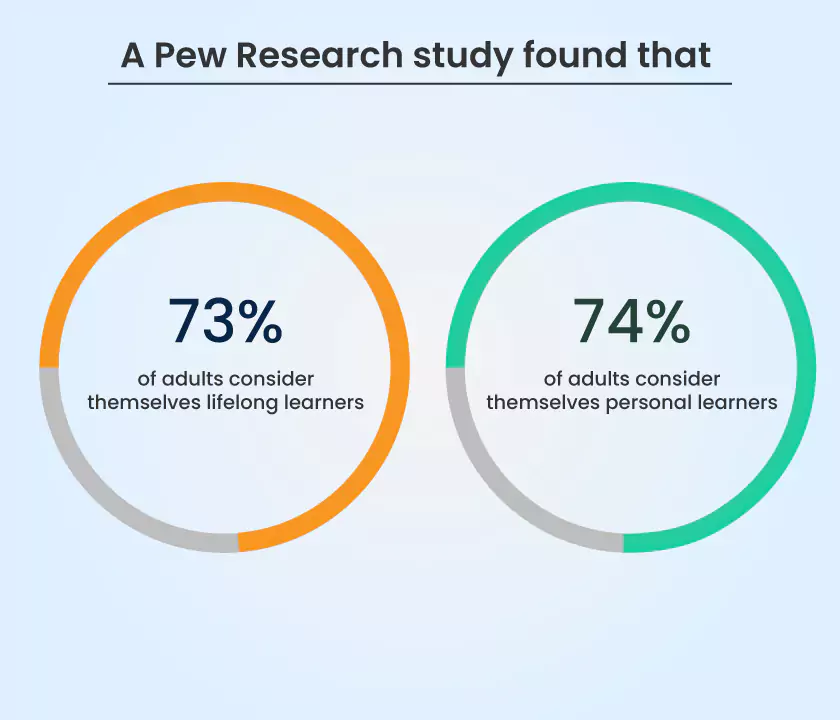
"Learning is not a destination, but a lifelong journey. The best initiatives are those that foster continuous growth."
The importance of strategic learning and development initiatives in the modern business world cannot be overstated. With rapidly advancing technologies and market dynamics, organizations must upskill their workforce to remain competitive.
Strategic initiatives for learning and development enable companies to identify skill gaps, and design targeted training & eLearning programs, to foster a culture of continuous learning. These initiatives help to attract and keep top talent by offering opportunities for professional growth and advancement.
This blog will explore some of the best strategic l&d initiatives organizations can adopt to enhance performance and stay ahead in the competitive landscape.
There are optimum learning and development initiatives that you can look forward to. These are:
Continuous learning enables professionals to seek out new fields of knowledge and create complementary skills that increase their flexibility. Individuals become more resourceful, resilient, and well-equipped to grab diverse career opportunities by broadening their skill portfolios.
A Pew Research study found that about 73% of adults consider themselves lifelong learners, and 74% are personal learners.

The study suggests staying informed and willing to learn is essential for success. Even those in the same field for a long time should stay updated with the latest information and trends. It will help them remain competitive and prepare for any changes.
Moreover, digital platforms have made continuous learning more accessible and convenient. Online courses, webinars, and virtual workshops allow people to learn at their own pace and from anywhere in the world. This flexibility enables individuals to expand their knowledge and stay ahead in their respective fields without time constraints.
For instance, many working professionals can sign up for an online course during their lunch break, complete it within a few months, and still keep up with their job. This way, they can learn new skills and advance their careers without taking a break. Online courses also provide flexible learning options, allowing you to learn at your own pace and schedule.
Talent Development and succession planning are two domains where online courses can greatly benefit organizations. By offering employees the opportunity to take online courses, organizations can invest in their talent and prepare them for future leadership roles.
Corporate l&d helps retain top performers and ensures a smooth transition of knowledge and skills within the organization. eLearning courses provide a cost-effective solution for talent development as they eliminate the need for expensive in-person l&d training programs.
For instance, a company can create a course on product knowledge and give access to employees across multiple locations, saving time and money spent on travel and accommodation costs. Employees can learn comfortably from their own homes, which helps to reduce stress and increases focus. The course can also be tailored to the individual needs of each employee.
Read Also: Best Practices for Custom eLearning Development
Leadership is a fundamental component of any successful organization. Investing in leadership development programs can help identify and nurture future leaders within the company. These programs typically include training, mentoring, coaching, and exposure to real-life leadership challenges. By developing effective leaders, organizations can create a strong and sustainable future for themselves.
Utilize a custom corporate elearning program that could include interactive modules on leadership skills, virtual mentoring sessions with experienced leaders, and virtual simulations to practice decision-making in challenging situations. By providing these resources online, the company can save costs and reach a larger audience of employees who can participate at their convenience.
The corporate l&d program also allows employees to learn at their own pace and revisit the materials whenever needed, promoting continuous learning and growth. The virtual nature of the program enables employees from different locations to connect and collaborate, fostering a sense of community and expanding their professional networks.
E-learning platforms offer various interactive and engaging content and resources, such as videos, quizzes, and simulations catering to different learning styles and preferences. These platforms provide real-time feedback and progress tracking, allowing employees to monitor their development and identify improvement areas.
According to a Statista report, global user inflow for e-learning platforms is around 9.5% in 2023, and it is expected to hit 11.6% by 2027. As these platforms become more popular and more accessible, businesses are recognizing the value of providing employees with a self-directed approach to learning.

E-learning is more efficient and cost-effective than traditional learning methods, allowing employees to develop skills more quickly and independently. That is why user inflow for e-learning platforms is expected to grow in the coming years.
Gamification is about using game-like elements and techniques to create engaging and interactive learning experiences. It involves using game mechanics such as points, levels, rewards, and leaderboards to motivate and encourage students to learn.
Teachers can create an engagement using game-based activities that encourages exploration and students to think critically and utilize their knowledge in real-world contexts. It also helps them to track student progress and make learning more enjoyable.
Gamification encourages students to work together in a fun and collaborative atmosphere. As a result, they can learn more effectively and keep information in memory for longer periods.
For example, educational institutions could implement gamification in their e-learning platform by creating virtual badges that students can earn and display on their profiles as a symbol of their accomplishments. Students can then compete with each other to earn the most badges, fueling friendly competition and further motivation to engage with the e-learning material.
Read Also: Gamification VS Game-Based Learning: The Basic Differences
Cross-functional training allows employees to understand how different departments within the organization interact with each other and how their work affects the organization's overall success. It facilitates collaboration, problem-solving, and communication, which leads to increased productivity and better results.
This training technique is designed to help employees understand the interconnectivity between various departments and the impact of their roles and responsibilities on the success of the organization as a whole.
For example, demonstrating how the sales team's performance directly affects the finance department's budgeting process helps employees understand the importance of collaboration and teamwork. This, in turn, can improve communication and cooperation, leading to improved productivity and efficiency. Ultimately, this can help the organization achieve its business objectives more effectively.
Strategic learning and development initiatives are instrumental in equipping employees with the essential knowledge and skills to excel in their roles. Organizations prioritizing and investing in these initiatives demonstrate their commitment to employee development, engagement, and overall success.
By embracing a comprehensive training program, fostering a continuous learning culture, leveraging technology, and investing in leadership development, organizations can remain at the forefront of innovation and achieve their strategic objectives.
Our micro-learning solutions offer digital training modules for employees that can help them stay up-to-date with the latest industry trends and best practices.
Share